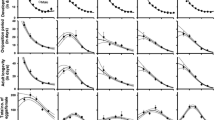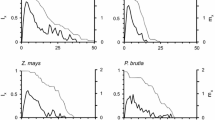Abstract
Euseius mesembrinus (Dean) (Acari: Phytoseiidae) was recently reported on Florida citrus for the first time. This mite was able to develop and reproduce when fed plant pollen of Spanish needle,Bidens pilosa L. and ice plant,Malephora crocea (Jacq.) or three spider mite species (Acari: Tetranychidae) including all stages ofTetranychus urticae Koch,Eutetranychus banksi (McGregor), and larval and nymphal stages only ofPanonychus citri (McGregor).
The biology ofE. mesembrinus was studied under laboratory conditions while being fed pollen ofM. crocea. The developmental time for immature stages at 18, 22, 26, and 30°C was 11.50, 7.47, 4.54, and 4.40 days, respectively. This pattern fits a log-probit model withr 2=0.940. Eggs hatched, but mortality in other stages was high at 34°C. The intrinsic rate of natural increase was 0.146, 0.250, and 0.246 at 22, 26, and 30°C. The optimum temperature for this phytoseiid to develop and increase on ice plant pollen was in the range of 26 to 30°C.
Similar content being viewed by others
References
Abou-Setta, M.M., Sorrell, R.W. and Childers, C.C., 1986. Life 48: A BASIC computer program to calculate life table parameters for an insect or mite species. Fla. Entomol.,69:690–697.
Baker, H.G. and Baker, I., 1979. Starch in angiosperm pollen grains and its evolutionary significance. Am. J. Bot., 66: 591–600.
Birch, L.C., 1948. The intrinsic rate of natural increase of an insect population. J. Anim. Ecol., 17: 15–26.
Browning, H.W., 1983. Spatial and temporal distribution of phytoseiid mites in Texas citrus groves. Proc. Fla. State Hortic. Soc., 96: 50–53.
Dean, H.A., 1957. Predators ofOligonychus pratensis (Banks), Tetranychidae. J. Econ. Entomol., 57: 164–165.
McCoy, C.W. and Rakha, M.A., 1985.Euseius mesembrinus (Acari: Phytoseiidae): A new record on Florida citrus and literature correction. Fla. Entomol., 68: 347–348.
McMurtry, J.A., 1983. Phytoseiid mites from Guatemala, with description of two new species and redefinition of the generaEuseius, Typhloseiopsis and theTyphlodromus occidentalis species-group (Acari: Mesostigmata). Int. J. Entomol., 25: 249–272.
McMurtry, J.A. and Scriven, G.T., 1964. Studies on the feeding, reproduction, and development ofAmblyseius hibisci (Acarina: Phytoseiidae) on various food substances. Ann. Entomol. Soc. Am., 57: 649–655.
McMurtry, J.A. and Scriven, G.T., 1965a. Life-history studies ofAmblyseius limonicus, with comparative observations onAmblyseius hibisci (Acarina: Phytoseiidae). Ann. Entomol. Soc. Am., 58: 106–111.
McMurtry, J.A. and Scriven, G.T., 1965b. Insectary production of phytoseiid mites. J. Econ. Entomol., 58: 282–284.
Moraes, G.J. de and Lima, H.C., 1983. Biology ofEuseius concordis (Chant) (Acarina: Phytoseiidae) a predator of the tomato russett mite. Acarologia, 24: 251–255.
Moraes, G.J. de and McMurtry, J.A., 1981. Biology ofAmblyseius citrifolius (Denmark and Muma) (Acarina-Phytoseiidae). Hilgardia, 49: 1–29.
Muma, M.H. and Denmark, H.A., 1970. Arthropods of Florida and Neighboring Land Areas. Vol. 6. Phytoseiidae of Florida. Fla. Dept. Agric. Cons. Serv., Div. Plant Industry, 150 pp.
Porres, M.A., McMurtry, J.A. and March, R.B., 1975. Investigation of leaf sap feeding by three species of phytoseiid mites by labelling with radioactive phosphoric acid (H3 32PO4). Ann. Entomol. Soc. Am., 68:871–872.
Rasmy, A.H., 1970. A laboratory technique for mass rearing of a phytoseiid mite. Z. Angew. Entomol., 65: 159–161.
Ristich, S.S., 1956. Mass rearing and testing technique forTyphlodromus fallacis (Garman). J. Econ. Entomol., 49: 476–479.
Shibles, R., 1976. Terminology pertaining to photosynthesis. Committee Report. Crop Sci., 16: 437–439.
Swirski, E., Amitai, S. and Dorzia, N., 1967. Laboratory studies on the feeding, development and reproduction of the predaceous miteAmblyseius rubini Swirski and Amitai andAmblyseius swirskii Athias-Henriot (Acarina: Phytoseiidae) on various kinds of food substances. Israel J. Agric. Res., 17: 101–119.
Swirski, E., Amitai, S. and Dorzia, N., 1970. Laboratory studies on the feeding habits, post-embryonic survival and oviposition of the predaceous miteAmblyseius chilenensis Dosse andAmblyseius hibisci Chant (Acarina: Phytoseiidae) on various kinds of food substances. Entomophaga, 15: 93–106.
Tanigoshi, L.K., Fargerlund, J. and Nishio-Wong, J.Y., 1981. Significance of temperature and food resources to the developmental biology ofAmblyseius hibisci (Chant) (Acarina, Phytoseiidae). Z. Angew. Entomol., 92: 409–419.
Author information
Authors and Affiliations
Additional information
Florida Agricultural Experiment Station Journal Series No. 7429.
Rights and permissions
About this article
Cite this article
Abou-Setta, M.M., Childers, C.C. Biology ofEuseius mesembrinus (Acari: Phytoseiidae): Life tables on ice plant pollen at different temperatures with notes on behavior and food range. Exp Appl Acarol 3, 123–130 (1987). https://doi.org/10.1007/BF01270474
Accepted:
Issue Date:
DOI: https://doi.org/10.1007/BF01270474




